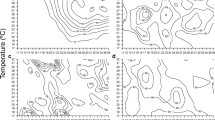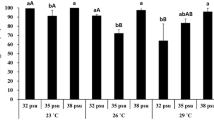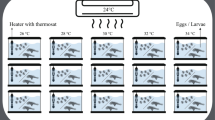Abstract
In spring 2004 and 2005 we performed two sets of experiments with Baltic sprat (Sprattus sprattus balticus Schneider) eggs and larvae from the Bornholm Basin simulating ten different temperature scenarios. The goal of the present study was to analyse and parameterise temperature effects on the duration of developmental stages, on the timing of important ontogenetic transitions, growth during the yolk sac phase as well as on the survival success of eggs and early larval stages. Egg development and hatching showed exponential temperature dependence. No hatching was observed above 14.7°C and hatching success was significantly reduced below 3.4°C. Time to eye pigmentation, as a proxy for mouth gape opening, decreased with increasing temperatures from 17 days post hatch at 3.4°C to 7 days at 13°C whereas the larval yolk sac phase was shortened from 20 to 10 days at 3.8 and 10°C respectively. Maximum survival duration of non-fed larvae was 25 days at 6.8°C. Comparing the experimental results of Baltic sprat with existing information on sprat from the English Channel and North Sea differences were detected in egg development rate, thermal adaptation and in yolk sac depletion rate (YSDR). Sprat eggs from the English Channel showed significantly faster development and the potential to develop at temperatures higher than 14.7°C. North Sea sprat larvae were found to have a lower YSDR compared to larvae from the Baltic Sea. In light of the predictions for global warming, Baltic sprat stocks could experience improved conditions for egg development and survival.








Similar content being viewed by others
References
Alheit J, Möllmann C, Dutz J, Kornilovs G, Loewe P, Mohrholz V, Wasmund N (2005) Synchronous regime shifts in the central Baltic and the North Sea in the late 1980s. ICES J Mar Sci 62:1205–1215
Alshuth S (1988) Bestimmung von Alter und Wachstumsraten bei Larven und Juvenilen der Sprotte, Sprattus sprattus L. Dissertation, Alfred-Wegener-Institut für Polar und Meeresforschung, Bremerhaven, 191p (in German)
Bisbal GA, Bengtson DA (1995) Effects of delayed feeding on survival and growth of summer flounder (Paralichthys dentatus) larvae. Mar Ecol Prog Ser 121:301–306
Blaxter JHS (1992) The effect of temperature on larval fishes. Neth J Zool 42:336–357
Brooks S, Tyler C, Sumpter JP (1997) Egg quality in fish: what makes a good egg? Rev Fish Biol Fish 7:387–416
Buckley LJ, Bradley TM, Allen-Guilmette J (2000) Production, quality, and low temperature incubation of eggs of Atlantic cod (Gadus morhua) and haddock (Melanogrammus aeglefinus) in captivity. J World Aquac Soc 1:22–29
Chambers RC (1997) Environmental influences on egg and propagule sizes in marine fishes. In: Chambers RC, Trippel EA (eds) Early life history and recruitment in fish populations. Chapman & Hall, London, pp 63–102
Chambers RC, Trippel EA (1997) The early life history of fishes and its role in recruitment processes. In: Chambers RC, Trippel EA (eds) Early life history and recruitment in fish populations (introduction). Chapman & Hall, London, pp xxi–xxxii
Conway DVP, Coombs SH, Smith C (1997) Vertical distribution of fish eggs and larvae in the Irish Sea and southern North Sea. ICES J Mar Sci 54:136–147
Cushing DH (1972) The production cycle and the numbers of marine fish. Symp Zool Soc Lond 29:213–232
Ehrenbaum E (1936) Naturgeschichte und wirtschaftliche Bedeutung der Seefischerei Nordeuropas. In: Lübbert H und Ehrenbaum E (eds) Handbuch der Seefischerei Nordeuropas, Band II; Schweizerbart´sche Verlagsgesellschaft, Stuttgart (in German)
Fox CJ, Geffen AJ, Blyth R, Nash RDM (2003) Temperature dependent development rates of plaice (Pleuronectes platessa L.) eggs from the Irish Sea. J Plankton Res 25:1319–1329
Fuiman LA (2002) Special considerations of fish eggs and larvae. In: Fuiman LA, Werner RG (eds) Fishery science: the unique contributions of early life stages. Blackwell Science, Oxford, pp 1–32
Fukuhara O (1990) Effects of temperature on yolk utilization, initial growth, and behavior of unfed marine fish-larvae. Mar Biol 106:169–174
Gaughan DJ, Fletcher WJ, White KV (2001) Growth rate of larval Sardinops sagax from ecosystems with different levels of productivity. Mar Biol 139:831–837
Grauman GB, Yula E (1989) The importance of abiotic and biotic factors in the early ontogenesis of cod and sprat. Rapp PV Réun Cons Perm Int Explor Mer 190:207–210
Hjort J (1914) Fluctuations in the great fisheries of northern Europe viewed in the light of biological research. Rapp PV Réun Cons Perm Int Explor Mer 160:1–228
Holliday FGT, Blaxter JHS (1960) The effects of salinity on the developing eggs and larvae of the herring. J Mar Biol Assoc UK 39:591–603
Houde ED (2002) Mortality. In: Fuiman LA, Werner RG (eds) Fishery science: the unique contributions of early life stages. Blackwell Science, Oxford, pp 64–87
IPCC (2002) Climate change and biodiversity—IPCC technical paper, vol V. IPCC, Geneva, pp 1–77
Kamler E (2002) Ontogeny of yolk-feeding fish: an ecological perspective. Rev Fish Biol Fish 12:79–103
Karås P, Klingsheim V (1997) Effects of temperature and salinity on embryonic development of turbot (Scophthalmus maximus L.) from the North Sea, and comparisons with the Baltic populations. Helgol Meeresunters 51:241–247
Köster FW, Hinrichsen HH, Schnack D, St John MA, MacKenzie BR, Tomkiewicz J, Möllmann C, Kraus G, Plikshs M, Makarchouk A, Aro E (2003) Recruitment of Baltic cod and sprat stocks: identification of critical life stages and incorporation of environmental variability into stock-recruitment relationships. Sci Mar 67:129–154
Kühn W, Peck MA, Hinrichsen H-H, Daewel U, Moll A, Pohlmann T, Tamm S (2008) Spatial and temporal changes in the habitat suitability of the German Bight (southern North Sea) for fish larvae: an IBM approach using size structures prey field. J Mar Syst (accepted)
Kuhlmann D, Quantz G (1980) Some effects of temperature and salinity on the embryonic development and incubation time of the turbot, Scophthalmus maximus L., from the Baltic Sea. Meeresforsch 28:172–178
Llanos-Rivera A, Castro LR (2006) Inter-population differences in temperature effects on Engraulis ringens yolk sac larvae. Mar Ecol Prog Ser 312:245–253
Lasker R (1964) An experimental study of the effect of temperature on the incubation time, and growth of Pacific sardine embryos and larvae. Copeia 2:399–405
Laurence GC, Rogers CA (1976) Effects of temperature and salinity on comparative embryo development and mortality of Atlantic cod (Gadus morhua L.) and haddock (Melanogrammus aeglefinus L.). J Cons Int Explor Mer 63:220–228
Litvak MK, Leggett WC (1992) Age and size-selective predation on larval fishes: the bigger-is-better hypothesis revisited. Mar Ecol Prog Ser 81:13–41
Loewe P, Becker G, Brockmann U, Frohse A, Herklotz K, Klein H, Schulz A (2005) Nordseezustand 2003 Ozeanographischer Zustandsbericht, vol 38. Berichte des Bundesamtes für Seeschiffahrt und Hydrography, 217pp (in German)
MacKenzie B, Gislason H, Möllmann C, Köster FW (2007) Impact of 21st century climate change on the Baltic Sea fish community and fisheries. Glob Change Biol 13:1348–1367
Morawa FWF (1953) Beiträge zur Biologie des Sprottes (Clupea sprattus) in der Ostsee. Dissertation, Institute of Marine Sciences, University of Kiel, Kiel, 102pp (in German)
Mohrholz V, Dutz J, Kraus G (2006) The impact of exceptional warm summer inflow events on the environmental conditions in the Bornholm Basin. J Mar Syst 60:285–301
Munk P (1993) Differential growth of larval sprat (Sprattus sprattus) across a tidal front in the eastern North Sea. Mar Ecol Prog Ser 99:17–29
Nissling A (2004) Effects of temperature on egg and larval survival of cod (Gadus morhua) and sprat (Sprattus sprattus) in the Baltic Sea-implications for stock development. Hydrobiologia 514:115–123
Nissling A, Westin L (1991) Egg buoyancy of Baltic cod (Gadus morhua) and its implications for cod stock fluctuations in the Baltic. Mar Biol 111:33–35
Nissling A, Westin L (1997) Salinity requirements for successful spawning of Baltic and Belt Sea cod and the potential for cod stock interactions in the Baltic Sea. Mar Ecol Prog Ser 152:261–271
Nissling A, Müller A, Hinrichsen HH (2003) Specific gravity and vertical distribution of sprat eggs in the Baltic Sea. J Fish Biol 63:280–299
Pritchard G, Harder LD, Mutch RA (1996) Development of aquatic insect eggs in relation to temperature and strategies for dealing with different thermal environments. Biol J Linn Soc Lond 58:221–244
Rothschild BJ (1986) Dynamics of marine fish populations. Harvard University Press, Cambridge, 277p
Rothschild BJ (2000) Fish stocks and recruitment: the past thirty years. ICES J Mar Sci 57:191–201
Shields RJ (1989) Studies of growth and nutritional status in 0-group sprat, Sprattus sprattus (Clupeidae), using otolith micostructure and lipid analytical techniques. Ph.D. thesis. School of Ocean Science, University of Wales Bangor, Anglesey, 124p
Thomas WH, Scotten HL, Bradshaw JS (1963) Thermal gradient incubators for small aquatic organisms. Limnol Oceanogr 8:357–360
Thompson BM, Milligan SP, Nichols JH (1981) The development rates of Sprat (Sprattus sprattus L.) eggs over a range of temperatures. ICES Council Meeting 1981/H:15
Trippel EA, Kjesbu OS, Solemdal P (1997) Effects of adult age and size structure on reproductive output in marine fishes. In: Chambers RC, Trippel EA (eds) Early life history and recruitment in fish populations. Chapman & Hall, London, pp 31–62
Trippel EA, Kraus G, Köster FW (2005) Maternal and paternal influences on early life history traits and processes of Baltic cod (Gadus morhua). Mar Ecol Prog Ser 303:259–267
Wahl E, Alheit J (1988) Changes in the distribution and abundance of sprat eggs during spawning season. ICES Council Meeting 1988/H:45
Von Westernhagen H (1970) Erbrütung von Dorsch (Gadus morhua), Flunder (Pleuronectes flesus) und Scholle (Pleuronectes platessa) unter kombinierten Temperatur- und Salzgehaltsbedingungen. Helgol wiss Meeresunters 21:21–102
Acknowledgements
This study was funded by the DFG (German Research Foundation) grant RECONN2 (CL 126/3-1) within the priority programme 1162 “AQUASHIFT” and by the GLOBEC-Germany programme (FKZ03F0320E0). We gratefully acknowledge Hans-Harald Hinrichsen, Jörn Schmidt, Jens-Peter Herrmann and the crew of RV “ALKOR” for providing us with sprat eggs and the support from Bastian Huwer and Helgi Mempel during the experimental phases. We would like to address special thanks to Prof. Myron Peck and Dr Rudi Voss for their helpful ideas concerning the preparation of and three anonymous reviewers for improving the manuscript. The experiments complied with the current animal care laws of the Federal Republic of Germany.
Author information
Authors and Affiliations
Corresponding author
Additional information
Communicated by U. Sommer.
Rights and permissions
About this article
Cite this article
Petereit, C., Haslob, H., Kraus, G. et al. The influence of temperature on the development of Baltic Sea sprat (Sprattus sprattus) eggs and yolk sac larvae. Mar Biol 154, 295–306 (2008). https://doi.org/10.1007/s00227-008-0923-1
Received:
Accepted:
Published:
Issue Date:
DOI: https://doi.org/10.1007/s00227-008-0923-1




